 |
 |
| Occussi-Ambeno |
|
Sultanate of Occussi-Ambeno (a
model country based on an actual enclave in what was Portuguese East Timor,
in Indonesia): This imaginary state, which obtained “independence from
Portugal in April 1968”, was masterminded by Mr. Bruce Henderson, a New
Zealander who is a noted film buff and who was once heavily involved in
sci-fi fandom. For this and other projects, he adopted the alias/nom
d'artiste of Bruce Grenville (I shall respectfully refer to him by that name
for the remainder of this write-up). Having perpetrated this ingenious
“hoax”, he rose to notoriety in the 1970s and 80s. Today, the Internet
almost invariably credits Mr. Henderson (not Mr. Grenville) as the visionary
who devised the infamous Occussi-Ambeno postage stamps. This oftentimes light-hearted venture was an opportunity for Mr. Grenville (he was already well-known in “anarchist” circles as a person who advocated freedom from “Statism”) to satirize the institution of the state and the trappings of its political apparatus. As part of what many critics would characterize as a “scam”, Mr. Grenville and his comrades fabricated an unique historical timeline and bureaucracy, including seven united provinces/tribes and a succession of rulers going back to 1848. Almost immediately, they began to print stamps, crests, letterheads, and other official-looking material. For publicity purposes, they also spawned countless press releases, many of which were published by the world's media. They have frequently made headlines; for example, The New Zealand Herald once carried a story about Occussi-Ambeno on its front page. Apparently, in 1973 it was the first and only state to establish full diplomatic relation with the Republic of Minerva, whose founders tried to seek recognition by sending letters to some 100 countries. Occussi-Ambeno itself once skillfully secured diplomacy with a number of other tiny states, including Monaco and Liechtenstein (part of this information appeared in The State Adversary, July 1987). They are professed to have been accidentally included in a list of countries compiled by the U.S. Dept. of State. Mr. Grenville's deliberate irreverence/flippancy probably alienated many influential people along the way, especially those who felt wrongly duped after the proverbial cat was out of the bag. Despite all the commotion he's caused, the melodic words “Occussi-Ambeno” simply would not be in our vocabulary if it were not for him. |
|
 |
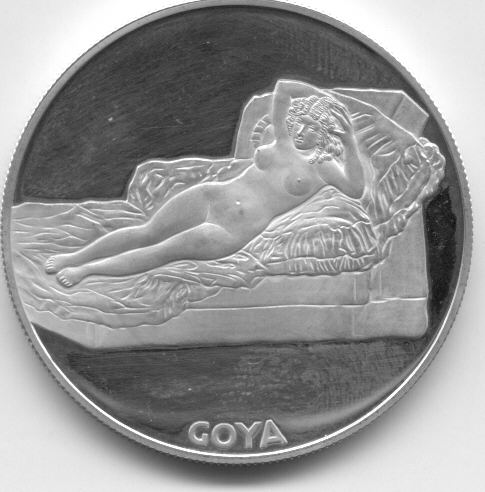 |
 |
 |
|
The Sultan of Occussi-Ambeno
was but one of Mr. Grenville's numerous alter-egos. He has become the
artist-in-residence for over a dozen re-created/mythical countries, and an
amazingly prolific originator of “cinderella” stamps. They are also known as
artistamps, an artform which proffers a colorful alternate universe all its
own. Mr. Grenville, as the Postmaster-General of the Okusi-Ambeno Philatelic
Bureau/Post Office oversees their entire catalog of stamps. Plus, he is the
current Secretary-General of the “International Council of Independent
States” (ICIS, founded by Norwegian archaeologist Geir Sør-Reime on June
1st, 1984). It acts as a kind of “United Nations” for the fictional realms
that belong to what he terms the “Fifth World”, and it brings together 20 or
so other artistamp-issuing states (e.g. Sultanate of Upper Yafa, Kingdom of
All the Sedang, Republic of Liegerland, Free Vinland Republic), many of
which are Mr. Grenville's progeny. In one of the chapters for James Warren
Felter's 216-page bilingual (Italian/English) paperback Artistamps, Mr.
Grenville writes that some philatelists “feel that stamps must originate
from a country to be considered relevant to collectors. Thus, the issuer is
forced to make the decision to create a ‘virtual country’”. Occussi-Ambeno's
“success has been because it really does have a geographical location” and
hobbyists become more interested when they can find a detailed map of the
pre-existing “stampiferous” country in an atlas and prove to themselves that
it is unequivocally real. Their current Head of State is His Majesty the
Sultan Gare (i.e. Gary Dean), though Mr. Grenville originally held that post
before being deposed. Though for a long spell it was unclear whether either of the Bruces was the same promoter behind the Occussi-Ambeno coins, I can now report with confidence (based on personal correspondence) that the numismatic items bearing its name are not official concoctions, and were with certainty produced sans consent. The various pieces from 1996/97 (showing themes related to Taiwan) and the two from 1990 (showing paintings of the nude maja/Venus) were purportedly struck by the Valcambi Mint in Switzerland. It is extremely unclear, however, who actually authorized the issuance of these coins; but based on reports from a close colleague, I've learned that a numismatist from Spain may have been responsible for the '90 pair. |
|
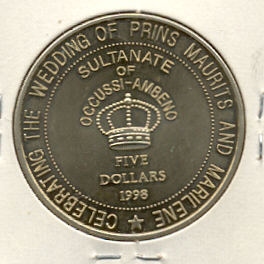 |
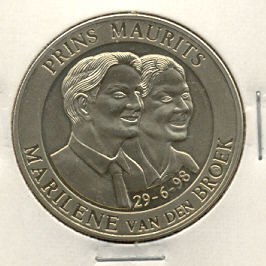 |
| In regards to the Swiss connection, the lone 1998 coin (Prins Maurits and Marilene van den Broek, of the Dutch Royal House) is the spurious exception. This hideous piece is theorized to be of Chinese origin, but compared to its very handsome predecessors, it was designed/engraved by much less capable hands. A fantasy based on a fantasy? A double fantasy, so to speak? Just as collectibly intriguing, at least to me. And to add food for a final bit of thought, here is an unexplainably peculiar tidbit I found at Google Groups (posted by a Mr. Brett McInnes): “The currency of Okusi-Ambeno is, of course, the Okusi-Ambeno Pataca, consisting of 100 avos. Coins circulate in denominations of 1,2,3,7,11,13,17,19,23,29 avos and 1, 2, and 3.14159265 patacas. The coins are struck on a patented planchet consisting of an alloy of mushrooms and another undisclosed substance also commonly found in connection with mushrooms.” Boy, this really adds another bizarre layer to the deepening mystery! We can infer, of course, that the author of this snippet was fully aware that apart from the revenues of its Philatelic Bureau, the Sultanate’s economy is completely dependent upon “exports of high quality hallucinogenic mushrooms manufactured in State-owned factories scattered throughout Okusi-Ambeno.” Though there is no page displaying the actual metallic coins, the official Web-site of the Kesultanan Okusi-Ambeno is http://okusi1.tripod.com/. According to this website 1 Dollar of Occussi-Ambeno is equivalent to 1.23 US Dollars. | |
| In the summer of 2004, someone named “Xavier Carlos Maria di Occussi-Ambeno” posted a couple of eyebrow-raising messages at the Unrecognised States Numismatic Society (http://groups.yahoo.com/group/UnrecognisedStatesNumismaticSociety/) newsgroup. Claiming to be “a member of the Royal Government of the Sultanate of Okusi-Ambeno” (no connection whatsoever to the regime of “the imaginative philatelist senhor Grenville” and Sultan Gare — both of whom he considers to be “pretenders” and “usurpers”), he stated that “We have been in exile since the Indonesian Army invaded our Sultanate in the 1970's. As of last year, the State of Timur-Leste has been re-enstated but, as of now, does not recognise our rights to the Sultanate. This means we are obliged to stay in exile until this can be rectified.” He furthermore asserted that there have been only 2 official patterns made by the sultanate-in-exile, both in 1998: a silver 1 Rupiyah, commemorating the 30th anniversary of autonomy (a very limited edition of 100 pieces was made), and a larger 5 Rupiyah silver pattern made for presentation purposes only. “These coins were not available to the public as the Javanese froze our assets within a few weeks after our minting of these, as they were scared by rumours (lies) of a revolt by our loyal subjects in Okusi.” Another reason to explain why those coins have never been distributed is because they “are as of now residing (ALL the coins as well as the dies) in a Luxemburg bank vault together with the rest of our frozen national assets. In 2003 we started a legal procedure at the European Court of Justice to get our assets unfrozen. As these were frozen by the order of the old Jakarta regime of Indonesia-Java (in 1999) there is now a distinct possibility they will be unfrozen shortly.” The latest update, based on personal correspondence from November of 2006, is that “I am still waiting with patience for the news from my sollicitors on the coins in Luxembourg. There is still no news.” Another major aim of his messages was to convince the USNSers that all other Occussi-Ambeno coins are fantasies, “UNAUTHORISED by the Royal Government.” Though the Prince presumes that some of those pieces — the ones featuring “a malformed and stylized version of the Okusi Fire Crown (which in turn was stolen from the Royal Treasury by the pretender Henderson and his followers in the early 70's)” — may have been minted with the consent of the New Zealand “fantast”, he was unable to confirm or deny this speculation. Finally, in order to support the reinstatement of the Royal Family, the “Royal Government in Exile” was planning to issue a new coin in 2005. Though this piece would’ve complemented the pair of inaccessible coins quite nicely, its production has been postponed indefinitely. | |
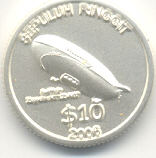 |
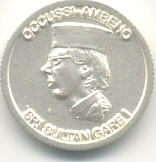 |
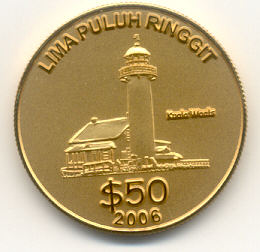 |
 |
| After nearly 40 years of existence, Occussi-Ambeno has finally offered its “first official” numismatic issues. Mr. Grenville and the Sultan himself personally authorized the minting of a pair of coins. The first piece is a silver-plated Sepuluh (10) Ringgit, featuring the “Swiftair Zeppelin NT LZ-N07”, the jewel of “Occussi-Ambeno's Airship Express Service.” The “Swiftair Corporation uses modern, safe, and fast high-tech airships filled with helium, an inert gas that will not ignite. It is 100% safe for airship travel. Swiftair's fleet of five zeppelins operates regularly within Occussi-Ambeno and also runs less frequent international links. Airships are ideally suited to delivering mail, passengers, and supplies to isolated outposts, where the ships can hover to transfer cargo.” The second piece is a gold-plated Limapuluh (50) Ringgit, depicting a lengthy building: “It is the control room for the Lighthouse, which is situated on the coast of Occussi-Ambeno at Kuala Waals.” Mr. Grenville explained the specific reason why those 2 denominations were chosen: “$50 is the price for an all-day pass for inland zeppelin flights within Occussi-Ambeno…Single trips are $10”. Both pieces, dated 2006, were produced with the assistance of Mr. Jorge Fernández Vidal (see my listing for Westarctica). Both coins were made on Sri Sultan Gare I's protrait: $10 (Sepuluh Ringgit) CuNi - Silver plated and $50 (Lima Puluh Ringgit) CuNi - Gold plated. | |
| In the end I would thank Erik V. McCrea for his above research and information. I purchased my 5 Dollar 1998 CuNi from him. This coin features the celebration of royal wedding of Prins Maurits and Marilene van den Broek on 29th June 1998. I purchased my 100 Dollar 1990 Goya and Velazquez silver coins plus 2006 dated coins through Oded Paz. Further minted coin of Occussi-Ambeno can be seen in Bruce's 4th edition of "Unusual Coins of the World" published by Krause publication. | |
| Micro-Nations | |
| Chiefa Coins | |